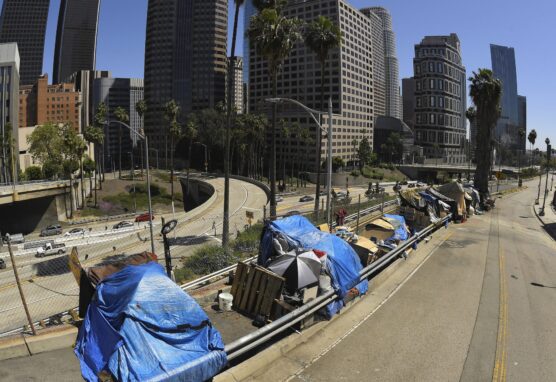The number of unhoused people living in Los Angeles rose sharply by 10% in the last year, according to the results of the latest “point-in-time” count conducted annually by the Los Angeles Homeless Services Authority, or LAHSA. The count also found 75,518 unhoused people living in Los Angeles County, a 9% rise compared to last year.
The count, which is required by the federal government in order to obtain certain funding, found 46,260 unhoused people living in the city of Los Angeles, up from last year’s tally of 41,980.
“We knew these numbers were going to go up,” Los Angeles Mayor Karen Bass said at a press conference Thursday morning. “The count shows the crisis continues.”
Tommy Newman, a vice president of United Way, said he was “disappointed but not surprised” by the count’s results. He blamed the end of various pandemic-era policies, like financial assistance and rental protections, and noted that L.A. saw a surge of evictions this year.
Each year, LAHSA places about 22,000 people into some form of housing. But there are more people becoming homeless than the department can deal with.
“We have to prevent people from falling into homelessness,” Bass said. “I’m worried that the count next year might be even higher, because of people falling into homelessness.”
L.A.’s homelessness increase is in line with a national trend. The country’s homeless population had already been rising, on average, about 6% every year. But there is every indication that the last year was worse. Homelessness in San Diego increased 22% over the last year; in Columbus Ohio, it rose 20%; Portland, Oregon, also saw a 20% increase; Chicago saw a staggering 58% increase, though that includes 2,196 asylum seekers from Central and South America, many bused in from Texas.
Chicago still has fewer than 1,000 unsheltered homeless, thanks to its extensive network of shelters. Not so in Los Angeles, where the number of people living in homeless shelters, about 13,500, stayed more or less the same, while the number of unsheltered homeless people rose by 15% in the city.
At the press conference, Loa Angeles city officials signaled they would focus on building more temporary housing to get people off the street and remove homeless encampments.
“We have to address unsheltered homelessness as never before,” said LAHSA CEO Va Lecia Adams Kellum.
Bass referenced New York’s extensive system of shelters and said, “I believe we need to build a system of interim” housing.
The number of chronically homeless, people in need of the most care, in terms of social services and treatment rose 18%. Homelessness rose the most in the western part of the county, along the coast.
Fighting homelessness is the top priority for Bass, who declared a “state of emergency” to address the crisis shortly after taking office this past December. This month, she announced that her new initiative, dubbed “Inside Safe,” has succeeded in moving 14,000 people off the streets. Much of that impact isn’t reflected in this year’s homeless count, which was conducted in January.
Newman praised “Inside Safe,” but wasn’t sure it would affect the overall number of homeless living in the city.
“It’s a good thing to be able to move big encampments indoors, to focus on visible homelessness,” Newman said. “But it’s not a strategy to address the inflow of people into homelessness.” He said the 2022 count proved that pandemic-era policies like renter protections and financial assistance could stem the tide of people falling into homelessness.
Double-digit rises in homelessness were a regular occurrence in L.A. during the late 2010s. Although there was no count in 2021 due to Covid, LAHSA found that homelessness “only” rose 1.7% between 2020 and 2022, a result that Newman called “a glimmer of hope.” But questions were later raised about that count’s accuracy. For example, as the Los Angeles Times reported, the count had found zero unsheltered homeless people living in the northwest quarter of the Venice Beach neighborhood, a notorious homeless hotspot, perhaps second only to Skid Row.
The homeless count is intended to be a “snapshot” of the number of homeless people living on the streets, in cars and in shelters at one specific time, when the count is conducted. Over the course of three days in January, thousands of volunteers walk the streets of L.A., counting tents and makeshift shelters, as well as vehicles in which it looks like people are likely living. Experts then take the number of dwellings and attach a “multiplier” — an estimated number of people living in a dwelling.
Los Angeles County Supervisor Lindsey Horvath said L.A. needs to “move away from annual point-in-time count” and toward a system of tracking homelessness in real time.
She added: “For those who are feeling disappointed, know that we are too.”
https://www.courthousenews.com/homeless-population-in-los-angeles-surged-10-in-last-year/
Like this:
Like Loading...
Related





 Tweet This
Tweet This Facebook
Facebook Digg This
Digg This Bookmark
Bookmark Stumble
Stumble RSS
RSS



























REAL NAMES ONLY: All posters must use their real individual or business name. This applies equally to Twitter account holders who use a nickname.
0 Comments
You can be the first one to leave a comment.